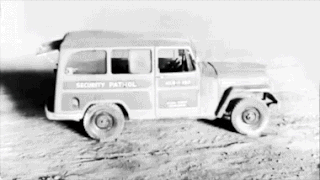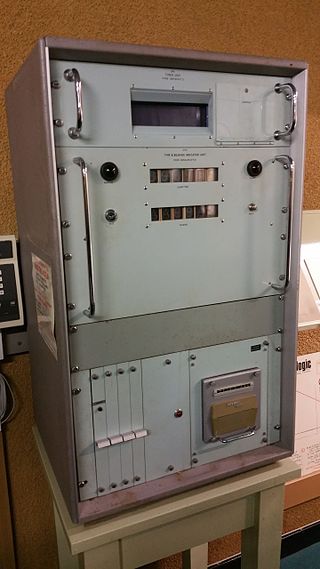
A nuclear weapon is an explosive device that derives its destructive force from nuclear reactions, either fission or a combination of fission and fusion reactions, producing a nuclear explosion. Both bomb types release large quantities of energy from relatively small amounts of matter.

Threads is a 1984 British-Australian apocalyptic war drama television film jointly produced by the BBC, Nine Network and Western-World Television Inc. Written by Barry Hines and directed and produced by Mick Jackson, it is a dramatic account of nuclear war and its effects in Britain, specifically on the city of Sheffield in Northern England. The plot centres on two families as a confrontation between the United States and the Soviet Union erupts. As the nuclear exchange between NATO and the Warsaw Pact begins, the film depicts the medical, economic, social and environmental consequences of nuclear war.

Nuclear warfare, also known as atomic warfare, is a military conflict or prepared political strategy that deploys nuclear weaponry. Nuclear weapons are weapons of mass destruction; in contrast to conventional warfare, nuclear warfare can produce destruction in a much shorter time and can have a long-lasting radiological result. A major nuclear exchange would likely have long-term effects, primarily from the fallout released, and could also lead to secondary effects, such as "nuclear winter", nuclear famine, and societal collapse. A global thermonuclear war with Cold War-era stockpiles, or even with the current smaller stockpiles, may lead to various scenarios including the extinction of the human species.

In nuclear strategy, a first strike or preemptive strike is a preemptive surprise attack employing overwhelming force. First strike capability is a country's ability to defeat another nuclear power by destroying its arsenal to the point where the attacking country can survive the weakened retaliation while the opposing side is left unable to continue war. The preferred methodology is to attack the opponent's strategic nuclear weapon facilities, command and control sites, and storage depots first. The strategy is called counterforce.

A nuclear bunker buster, also known as an earth-penetrating weapon (EPW), is the nuclear equivalent of the conventional bunker buster. The non-nuclear component of the weapon is designed to penetrate soil, rock, or concrete to deliver a nuclear warhead to an underground target. These weapons would be used to destroy hardened, underground military bunkers or other below-ground facilities. An underground explosion releases a larger fraction of its energy into the ground, compared to a surface burst or air burst explosion at or above the surface, and so can destroy an underground target using a lower explosive yield. This in turn could lead to a reduced amount of radioactive fallout. However, it is unlikely that the explosion would be completely contained underground. As a result, significant amounts of rock and soil would be rendered radioactive and lofted as dust or vapor into the atmosphere, generating significant fallout.

World War III, World War 3, WWIII, WW3, or the Third World War are the names given to a hypothetical global conflict subsequent to World War I and World War II. The term has been in use since as early as 1941. Some apply it loosely to limited or more minor conflicts such as the Cold War or the war on terror. In contrast, others assume that such a conflict would surpass prior world wars in both scope and destructive impact.

The effects of a nuclear explosion on its immediate vicinity are typically much more destructive and multifaceted than those caused by conventional explosives. In most cases, the energy released from a nuclear weapon detonated within the lower atmosphere can be approximately divided into four basic categories:

"Duck and cover" is a method of personal protection against the effects of a nuclear explosion. Ducking and covering is useful in offering a degree of protection to personnel located outside the radius of the nuclear fireball but still within sufficient range of the nuclear explosion that standing upright and uncovered is likely to cause serious injury or death. In the most literal interpretation, the focus of the maneuver is primarily on protective actions one can take during the first few crucial seconds-to-minutes after the event, while the film of the same name and a full encompassing of the advice also cater to providing protection up to weeks after the event.

Elugelab, or Elugelap, was an island, part of the Enewetak Atoll in the Marshall Islands. It was destroyed by the world's first true hydrogen bomb test on 1 November 1952, a test which was codenamed shot "Mike" of Operation Ivy. Prior to being destroyed, the island was described as "just another small naked island of the atoll".

In 1952, the United Kingdom became the third country to develop and test nuclear weapons, and is one of the five nuclear-weapon states under the Treaty on the Non-Proliferation of Nuclear Weapons.

The United Kingdom Warning and Monitoring Organisation (UKWMO) was a British civilian organisation operating to provide UK military and civilian authorities with data on nuclear explosions and forecasts of fallout across the country in the event of nuclear war.

Seven Days to the River Rhine was a top-secret military simulation exercise developed at least since 1964 by the Warsaw Pact. It depicted the Soviet Bloc's vision of a seven-day nuclear war between NATO and Warsaw Pact forces.
Philip Jarvis Dolan was an American physicist. He graduated from West Point in 1945, was assigned to the Manhattan Project in Los Alamos in 1948, and received his MSc in physics from the University of Virginia in 1956.
A salted bomb is a nuclear weapon designed to function as a radiological weapon by producing larger quantities of radioactive fallout than unsalted nuclear arms. This fallout can render a large area uninhabitable. The term is derived both from the means of their manufacture, which involves the incorporation of additional elements to a standard atomic weapon, and from the expression "to salt the earth", meaning to render an area uninhabitable for generations. The idea originated with Hungarian-American physicist Leo Szilard, in February 1950. His intent was not to propose that such a weapon be built, but to show that nuclear weapon technology would soon reach the point where it could end human life on Earth.

Atomic Weapons Detection Recognition and Estimation of Yield known by the acronym AWDREY was a desk-mounted automatic detection instrument, located at 12 of the 25 Royal Observer Corps (ROC) controls, across the United Kingdom, during the Cold War. The instruments would have detected any nuclear explosions and indicated the estimated size in megatons.

Project E was a joint project between the United States and the United Kingdom during the Cold War to provide nuclear weapons to the Royal Air Force (RAF) until sufficient British nuclear weapons became available. It was subsequently expanded to provide similar arrangements for the British Army of the Rhine. A maritime version of Project E known as Project N provided nuclear depth bombs used by the RAF Coastal Command.
In nuclear strategy, a counterforce target is one that has a military value, such as a launch silo for intercontinental ballistic missiles, an airbase at which nuclear-armed bombers are stationed, a homeport for ballistic missile submarines, or a command and control installation.

A nuclear close call is an incident that might have led to at least one unintended nuclear detonation or explosion, but did not. These incidents typically involve a perceived imminent threat to a nuclear-armed country which could lead to retaliatory strikes against the perceived aggressor. The damage caused by international nuclear exchange is not necessarily limited to the participating countries, as the hypothesized rapid climate change associated with even small-scale regional nuclear war could threaten food production worldwide—a scenario known as nuclear famine. There have also been a number of accidents involving nuclear weapons, such as crashes of nuclear armed aircraft.
Dust defense, sometimes called environmental defense, was a proposed anti-ballistic missile (ABM) system considered for protecting both Minuteman and MX Peacekeeper missile silos from Soviet attack.
Hard Rock was a British civil defence exercise planned by the Conservative government to take place in September–October 1982. One of a series of regular national civil defence exercises, it followed Square Leg in 1980. As the public reaction to the scale of devastation forecast in Square Leg was poor, the planner deliberately scaled down the number of warheads supposed for Hard Rock. Despite this, the Campaign for Nuclear Disarmament (CND), who opposed nuclear warfare and were against civil defence exercises, suggested that such an attack as Hard Rock anticipated would have led to the deaths of 12.5 million people.














